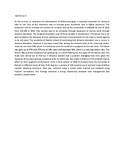| dc.contributor.author | Ndiritu, A, | |
| dc.contributor.author | Chandi, R | |
| dc.contributor.author | Rugendo, Caroline | |
| dc.date.accessioned | 2015-07-22T08:26:42Z | |
| dc.date.available | 2015-07-22T08:26:42Z | |
| dc.date.issued | 2015-07-19 | |
| dc.identifier.citation | Ndiritu A, Chandi R, Rugendo Caroline. "Balancing work and study: A necessity for successful Distance Learning.". In: 2nd AFRICE International Conference | en_US |
| dc.identifier.uri | http://hdl.handle.net/11295/88535 | |
| dc.description.abstract | As the country re- evaluates the achievement of Millennium goals, it becomes important for Kenya to take its toll. One of the intentions was to increase gross enrolment rate in higher education. The projection was to increase the number of students joining the universities to 450,000 by end of 2015 from 130,000 in 2008. This number was to be increased through expansion of courses done through distance education. The targeted population was of those already in employment. This group has to be able to balance the demands of their workplace and their social demands for the back to school agenda to be achieved. The university of Nairobi school of continuing and distance education runs a course in distance education. However It has been noted that among the students who sit for university exams, many do not score 40% which is a minimum score for students to progress to the next level. The failure rate goes up to 63% with 27% out of 38% cases scoring below 40%, which is a very high failure rate. This failure rate prohibits students from graduating. it is worth finding out the cause of this failure rate. This study was carried out to find out if distance learners had a problem managing their time given the demands of the same among competing ends. An effort was also made to find out if this problem had an effect on their academic performance. From a total number of 4500 of students from the University of Nairobi in different levels of their B.Ed degrees, a sample of 650 students were selected using stratified random sampling technique .Data was collected using a mixed mode method and analyzed using Pearson correlations. The findings indicated a strong relationship between time management and academic performance (r=0.569) | en_US |
| dc.language.iso | en | en_US |
| dc.publisher | University of Nairobi | en_US |
| dc.subject | work study balance, distance education, time management, Academic performance | en_US |
| dc.title | Balancing work and study A necessity for successful Distance Learning | en_US |
| dc.type | Presentation | en_US |
| dc.type.material | en | en_US |

